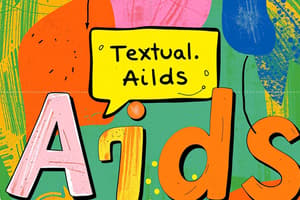Podcast
Questions and Answers
What is the primary purpose of textual aids in a text?
What is the primary purpose of textual aids in a text?
- To add visual appeal to the text
- To facilitate understanding, clarify complex information, and make the content more appealing and interactive (correct)
- To replace written text with images
- To provide a summary of the main points
Which of the following is an example of a textual aid?
Which of the following is an example of a textual aid?
- A paragraph
- A heading (correct)
- A footnote
- A bibliography
What is the benefit of using flowcharts as a textual aid?
What is the benefit of using flowcharts as a textual aid?
- To provide a concise summary of the main points
- To add visual interest to the text
- To visually represent a sequence of events or steps to follow (correct)
- To replace written text with images
How do textual aids contribute to improved comprehension?
How do textual aids contribute to improved comprehension?
What is the benefit of using images as a textual aid?
What is the benefit of using images as a textual aid?
How do textual aids contribute to increased retention?
How do textual aids contribute to increased retention?
Flashcards are hidden until you start studying
Study Notes
Definition and Purpose
- Textual aids are visual or graphic elements added to a text to enhance comprehension, retention, and engagement.
- Their purpose is to facilitate understanding, clarify complex information, and make the content more appealing and interactive.
Types of Textual Aids
- Images: photographs, diagrams, charts, graphs, and illustrations that support the text.
- Tables: organized data presented in rows and columns to facilitate comparison and analysis.
- Flowcharts: visual representations of a sequence of events or steps to follow.
- Infographics: visual representations of information that combine images, charts, and minimal text.
- Headings and Subheadings: organizational tools that break up the text and provide a clear structure.
- Bullet points and numbered lists: concise and organized presentation of information.
- Captions and annotations: additional text that provides context or explanation for images or other visual elements.
Benefits of Textual Aids
- Improved comprehension: visual aids can help readers understand complex concepts and relationships.
- Enhanced engagement: images and other visual elements can increase interest and motivation to read.
- Increased retention: visual aids can aid in memory retention by providing a mental image to associate with the text.
- Better organization: textual aids can help to organize and structure the content, making it easier to follow.
- Accessibility: textual aids can make the content more accessible to readers with different learning styles or abilities.
Textual Aids
- Textual aids are added to enhance comprehension, retention, and engagement by facilitating understanding, clarifying complex information, and making content more appealing and interactive.
Types of Textual Aids
- Images include photographs, diagrams, charts, graphs, and illustrations that support the text.
- Tables present organized data in rows and columns for easy comparison and analysis.
- Flowcharts visually represent a sequence of events or steps to follow.
- Infographics combine images, charts, and minimal text to represent information.
- Headings and subheadings organize text and provide a clear structure.
- Bullet points and numbered lists present information concisely and organized.
- Captions and annotations provide context or explanation for images or other visual elements.
Benefits of Textual Aids
- Visual aids improve comprehension by helping readers understand complex concepts and relationships.
- Images and visual elements increase engagement and motivation to read.
- Visual aids aid in memory retention by providing a mental image to associate with the text.
- Textual aids help organize and structure content, making it easier to follow.
- Textual aids make content more accessible to readers with different learning styles or abilities.
Studying That Suits You
Use AI to generate personalized quizzes and flashcards to suit your learning preferences.




